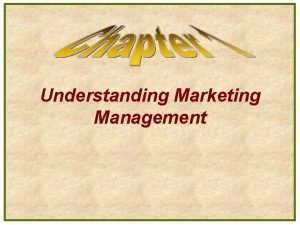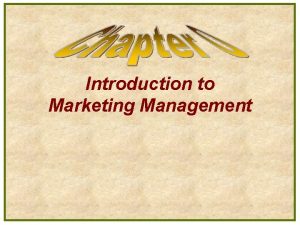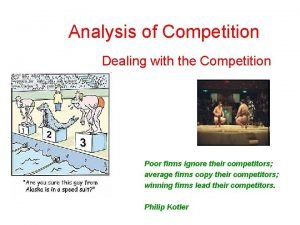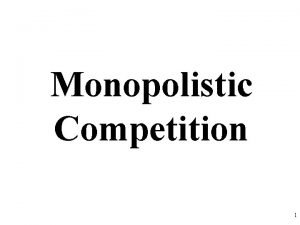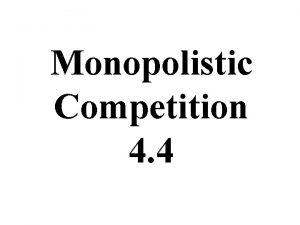11 Dealing with Competition Marketing Management 13 th


















- Slides: 18

11 Dealing with Competition Marketing Management, 13 th ed

Chapter Questions (cont. ) • How do marketers identify primary competitors? • How should we analyze competitors’ strategies, objectives, strengths, and weaknesses? • How can market leaders expand the total market and defend market share? Copyright © 2009 Pearson Education, Inc. Publishing as Prentice Hall 11 -2

Chapter Questions (cont. ) • How should market challengers attack market leaders? • How can market followers or nichers compete effectively? Copyright © 2009 Pearson Education, Inc. Publishing as Prentice Hall 11 -3

Five Forces Determining Segment Structural Attractiveness • • • Industry competitors Potential entrant Suppliers Buyers Substitutes Copyright © 2009 Pearson Education, Inc. Publishing as Prentice Hall 11 -4

Industry Concept of Competition • Number of sellers and degree of differentiation • Entry, mobility, and exit barriers • Cost structure • Degree of vertical integration • Degree of globalization Copyright © 2009 Pearson Education, Inc. Publishing as Prentice Hall 11 -5

Strengths and Weaknesses • Share of market • Share of mind • Share of heart Copyright © 2009 Pearson Education, Inc. Publishing as Prentice Hall 11 -6

Steps in Benchmarking • Determine which functions or processes to benchmark • Identify the key performance variables to measure • Identify the best-in-class companies • Measure the performance of best-inclass companies Copyright © 2009 Pearson Education, Inc. Publishing as Prentice Hall 11 -7

Steps in Benchmarking (cont. ) • Measure the company’s performance • Specify programs and actions to close the gap • Implement and monitor results Copyright © 2009 Pearson Education, Inc. Publishing as Prentice Hall 11 -8

Expanding the Total Market • New customers • More usage Copyright © 2009 Pearson Education, Inc. Publishing as Prentice Hall 11 -9

Six Types of Defense Strategies • • • Defender Flank Preemptive Counteroffensive Mobile Contraction Copyright © 2009 Pearson Education, Inc. Publishing as Prentice Hall 11 -10

Factors Relevant to Pursuing Increased Market Share • Possibility of provoking antitrust action • Economic cost • Pursuing the wrong marketing-mix strategy • The effect of increased market share on actual and perceived quality Copyright © 2009 Pearson Education, Inc. Publishing as Prentice Hall 11 -11

Other Competitive Strategies • Market challengers • Market followers • Market nichers Copyright © 2009 Pearson Education, Inc. Publishing as Prentice Hall 11 -12

Market Challenger Strategies • Define the strategic objective and opponents • Choose a general attack strategy • Choose a specific attack strategy Copyright © 2009 Pearson Education, Inc. Publishing as Prentice Hall 11 -13

General Attack Strategies • • • Frontal attack Flank attack Encirclement attack Bypass attack Guerilla warfare Copyright © 2009 Pearson Education, Inc. Publishing as Prentice Hall 11 -14

Specific Attack Strategies • • • Price discounts Lower-priced goods Value-priced goods Prestige goods Product proliferation Product innovation • Improved services • Distribution innovation • Manufacturing-cost reduction • Intensive advertising promotion Copyright © 2009 Pearson Education, Inc. Publishing as Prentice Hall 11 -15

Market Follower Strategies • • Counterfeiter Cloner Imitator Adapter Copyright © 2009 Pearson Education, Inc. Publishing as Prentice Hall 11 -16

Niche Specialist Roles • End-User Specialist • Vertical-Level Specialist • Customer-Size Specialist • Specific-Customer Specialist • Geographic Specialist • Product-Line Specialist • Job-Shop Specialist • Quality-Price Specialist • Service-Specialist • Channel Specialist Copyright © 2009 Pearson Education, Inc. Publishing as Prentice Hall 11 -17

Balancing Orientations • Competitor-centered • Customer-centered Copyright © 2009 Pearson Education, Inc. Publishing as Prentice Hall 11 -18
 Dealing with competition in marketing
Dealing with competition in marketing Dealing with competition marketing management
Dealing with competition marketing management Monopoly characteristics
Monopoly characteristics Perfect competition vs monopolistic competition
Perfect competition vs monopolistic competition Monopoly vs oligopoly venn diagram
Monopoly vs oligopoly venn diagram Perfect competition vs monopolistic competition
Perfect competition vs monopolistic competition Social marketing competition
Social marketing competition Understanding marketing management
Understanding marketing management Objectives of marketing management
Objectives of marketing management Marketing meaning
Marketing meaning Defining marketing for the new realities ppt
Defining marketing for the new realities ppt Assimilation linguistics
Assimilation linguistics Abiotic factors examples
Abiotic factors examples Section 2 dealing with other nations
Section 2 dealing with other nations Call center stress syndrome
Call center stress syndrome Science fiction
Science fiction Chapter 5 lesson 1 dealing with anxiety and depression
Chapter 5 lesson 1 dealing with anxiety and depression Chapter 5 lesson 1 dealing with anxiety and depression
Chapter 5 lesson 1 dealing with anxiety and depression Unit 1 dealing with incoming calls
Unit 1 dealing with incoming calls







